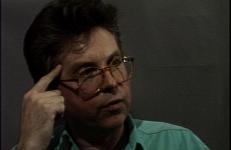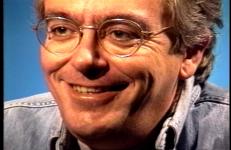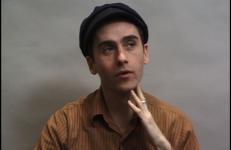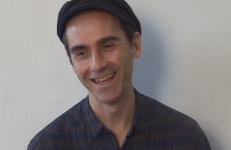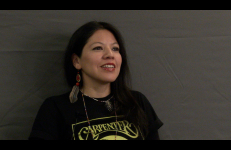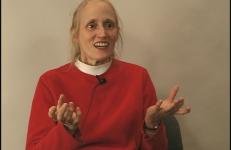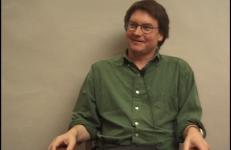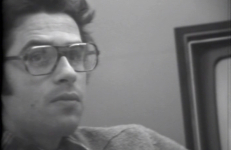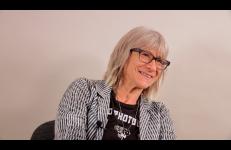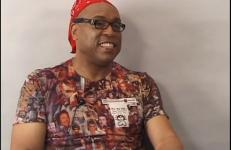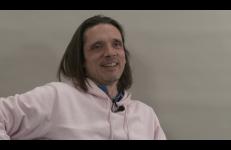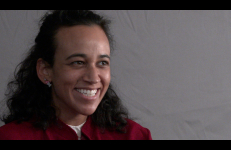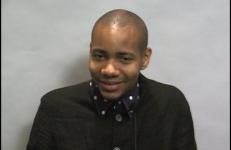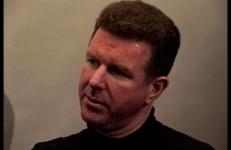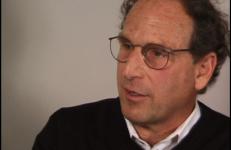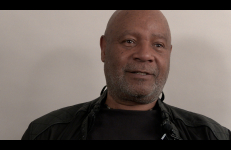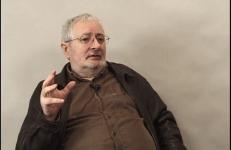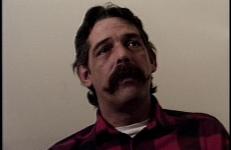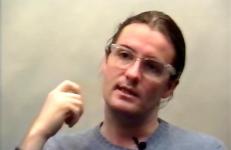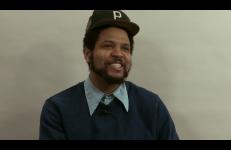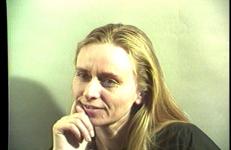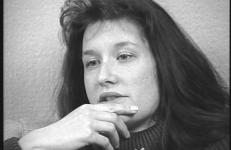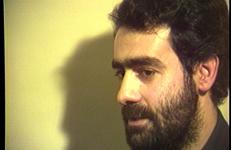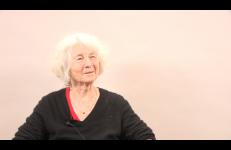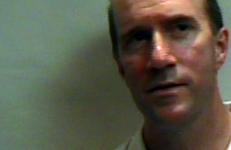John Arthur Clark (1943-1989) was born in Yorkshire, England. He attended Hull College of Art, receiving a National Diploma in Art and Design (N.D.D.) in painting. From 1966 to 1968 he attended Indiana University, receving an M.F.A. in painting. From 1968 to 1978 he was a lecturer in Fine Art and Art History at Hull College of Art and Newcastle Polytechnic. He emigrated to Canada in 1978 and became coordinator of painting and drawing at the Nova Scotia College of Art and Design.
VDB Interviews
Spanish painter Chema Cobo discusses his early years of studying and creating art in Southern Spain. His career began in the mid-1970s, exhibiting at the Buades and Vandrés galleries, along with a generation of now-established artists. His work began showing outside of Spain in the ’80s. Cobo also talks about the ways that his Spanish background and identity have informed his work.
A historical interview originally recorded in 1994.
In this 2001 interview, filmmaker Jem Cohen discusses the origins of his film philosophy, and the circuitous route he has taken in his pursuit of an anti-narrative film practice outside the mainstream. Cohen sheds light on the many influences that have impacted his sentiments towards conventional film, and his desire to eschew both classical avant-garde and theatrical filmmaking in favor of a model rooted in the tradition of the 1940s New York School of street photography. Cohen also locates his aesthetic as being impacted by the 1970s hardcore and DIY scenes he was exposed to as a youth in Washington, DC.
In this 2006 interview, filmmaker Jem Cohen discusses his early interest in art, his family’s welcome antipathy towards commercialization, and his unconventional, anti-mainstream film practice. In particular, Cohen discusses his film This is a History of New York, and how this piece exemplifies his interest in the “territory of sensation” rather than simple visual descriptiveness. Cohen concludes by discussing the role of archiving in his practice, and how compulsive documentation of the quotidian and unexceptional can result in the empowerment of the everyday.
Colectivo Los Ingrávidos (Tehuacán) is a Mexican film collective founded in 2012 to dismantle the commercial and corporate audiovisual grammar and its embedded ideology. The collective is inspired by the historical avant-gardes, and their commitment to using both form and content against alienating realities. Their methods combine digital and analog mediums, interventions on archival materials, mythology, agitprop, social protests, and documentary poetry.
In this interview American filmmaker, poet, and lyricist, Cecelia Condit gives shape to the contours of her work process. The artist describes the influence of her relationship with her mother, her long-term investment in the macabre, and her ongoing desire to confront death through art. While covering a broad range of topics, Condit’s discussion of her work and interests returns to several defining themes: aging, grotesqueness, and the notion of movement, both in terms of her own past as a dancer and the notion of the body in decay. With a particular emphasis on the production and context of her videos, Annie Lloyd (2008), and All About a Girl (2004), this interview offers insight into the artist’s fascination with aging, sweetness, and storytelling, while also articulating her joyful sense of discovery within the art-making process. No longer working with scripts, Condit presents herself in the interview as a scavenger–much like the crows she incorporates into her work–assembling videos which straddle the line between strange and silly. – Faye Gleisser
Matthew Coolidge is a founder and director of The Center for Land Use Interpretation (CLUI), an organization dedicated to raising awareness about how land is apportioned, used and perceived by its inhabitants. Through exhibitions, publications, and guided tours, Coolidge and the CLUI seek to foster and encourage a heightened sense of awareness of natural surroundings. In this interview, Coolidge defines a ‘land art spillover effect,’ in which the perceived significance of the landscape seems to increase the closer people get to a piece of environmental art.
Robert Cumming (b. 1943) is an American photographer/sculptor/bookmaker who borrows from the artifice of theatrical sets to construct his elaborate and often absurd images. He has also published several books of photography and narration. Central to his work is his desire to remind us that we are looking at a photograph, and not at the thing being photographed. His captions sometimes draw on a photograph's narrative aspects or are used to mislead the viewer.
Ann Cvetkovich is the Ellen Clayton Garwood Centennial Professor of English and Professor of Women’s and Gender Studies at the University of Texas at Austin. She is the author of a number of books and works also with documentary film, memoirs, music and dance performances, and visual art. Her work focuses on feminist and queer theory, affect and feeling, trauma, theories of the archive and oral history.
In this interview, American artist, independent curator, writer, and experimental filmmaker, Vaginal Davis reflects on her initiation into the punk rock and art scenes of Los Angeles during the 1980s and 90s, her stylistic influences, and her ongoing efforts to theorize queerness and visuality. Caught between the opposing poles of Hollywood classicism and the rawness of punk, Davis defines her unapologetically gender-bending, campy, and at times aggressively critical performances as scenarios, rather than spectacles or entertainment.
Turner Prize winning conceptual artist Jeremy Deller works across many different mediums, creating highly political and frequently collaborative works. Defying conventionality, Deller often exhibits outside of traditional gallery spaces, such as his 1993 twist on artist open studios, Open Bedroom, a secret exhibition in Deller’s family home while his parents were on holiday.
Nazlı Dinçel’s hand-made work reflects on experiences of disruption. They record the body in context with arousal, immigration, dislocation and desire with the film object: its texture, color and the tractable emulsion of the 16mm material. Their use of text as image, language and sound imitates the failure of memory and their own displacement within a western society. Born in Ankara, Turkey, Dinçel immigrated to the United States at age 17. Dinçel resides in Milwaukee, WI where they are currently building an artist run film laboratory.
Paul D. Miller (b. 1970) is a conceptual artist, writer, and musician better known as DJ Spooky. A popular and prolific recording artist, he has collaborated with Ryuichi Sakamoto, Butch Morris, Yoko Ono, Thurston Moore (of Sonic Youth), Kool Keith, and Killa Priest (of Wu Tang Clan). Miller’s work uses a wide variety of digitally created music as a form of postmodern sculpture.
Northern Irish artist Willie Doherty (b. 1959) works in photography and video installation. Since the late 1980s, his work has responded to the urban setting and rural outskirts of his hometown of Derry, Northern Ireland. Doherty’s artworks tend to begin as responses to specific terrains (most often mysterious isolated settings; places, we suspect, with a troubled past) and evolve as complex reflections on how we look at such locations — or on what stories might be told about their hidden histories.
Nathaniel Dorsky’s films are precise articulations of cinematic qualities: the surprise of an edit, the composition of framing, and the flash of the image. Dubbed the “filmmaker’s filmmaker”, Dorsky’s work captures the fleeting moments of everyday life in its poetic chaos in such films as Pneuma (1976-82), Triste (1974-96), Alaya (1976-87), and Variations (1992-98). Using a spring-wound Bolex and 16mm reversal stock film, Dorsky’s films operate in the realm of the purely visual.
Emory Douglas is a political artist and activist, producing revolutionary art for important political movements. He joined the Black Panther Party in 1967 and was the Minister of Culture for the Party, and created powerful illustrations and collages for the movement and the Party’s Black Panther Newspaper until the Party dissolved in the early 1980s. In this interview with Sampada Aranke, Douglas speaks about joining the Black Panthers as well as the creation and social and political impact of the Black Panther Newspaper.
In this interview, political and social theorist, Terry Eagleton (b. 1943), shares stories of his Irish upbringing and British education, and sums up his current engagement with art theory, leftist politics, and spirituality under capitalism. With reference to Henry James, Frederic Jameson, Christopher Hitchens, and Richard Dawkins, among others, this interview spans a vast landscape of literature and social theory.
Felipe Ehrenberg is a prominent Mexican artist who has been actively producing interactive political art, installations, and murals for more than 30 years. Also a writer, Ehrenberg has run a small press in Mexico City and has published numerous articles for art journals in the United States.
Interview by Carol Becker.
Berlin-based Danish artist Olafur Eliasson complicates and simulates perception through his installations, sculptures, and photographs. He has created disorienting artificial illuminations and reproduced natural phenomena such as clouds, glaciers and the sun through large-scale, high-tech installations.
In this interview, African American filmmaker and DJ Ephraim Asili (b. 1979) discusses his upbringing, education, and creative process. Born and raised around the city limit of Philadelphia, Asili’s childhood and adolescence were imbued with hip hop music, Hollywood movies and television.
German curator Ute Eskildsen (b. 1947) was born in Itzehoe (Schleswig-Holstein). After studying photography and working as an assistant in a fashion and portrait studio, she went on to study photography and the history of photography at the Folkwang School of Portraiture in Essen. A fellow in Visual Communication at the Essen University, she served as assistant to Otto Steinert in the field of photo-history exhibitions.
Karen Finley is well known for her confrontational monologues, often performed in clubs and bars, which exploit the stereotype of the hysterical woman to address the sexual and political taboos associated with femininity. Using a variety of unusual props, such as Jello, chocolate syrup, stuffed animals, and glitter, Finley provokes her audience into thinking about a range of repressions and contradictions in contemporary society. She gained mainstream attention when Congress questioned her NEA funding in the early 1990s.
Interview by Tom Jaremba.
Joan Fontcuberta was born in Barcelona in 1955. His work has been widely exhibited internationally. Fontcuberta uses photography as a conceptual medium, often testing the limits of the image’s credibility. Fauna (1987) and Sputnik (1997) take advantage of photography’s documentary quality to pose elaborate hoaxes. In recent work, Fontcuberta explores and criticizes the image and its proliferating sources with works such as Orogensis/Landscapes Without Memory (2002) and Googlegrams (2005).
The later 1950s and early 1960s saw the development and proliferation of radically new forms of dance driven by a desire to understand the essentiality of movement divorced from traditional, balletic and modern syntaxes. At the forefront of this new wave of performance was Simone Forti, an artist with a hand in both improvisational techniques and choreographed task-maneuvers. This interview details her exploration of each – with a particular focus on her earliest investigations into movement, owing to time spent under the study of Anna Halprin.
Hal Foster is Professor of Modern Art at Princeton University, and has written and edited numerous influential books on postmodernism, art, and culture. His books include Recodings: Art, Spectacle, Cultural Politics (1985); The Return of the Real: The Avant-Garde at the End of the Century (1996); and, as editor, The Anti-Aesthetic: Essays on Postmodern Culture (1983); Vision and Visuality (1988); and Richard Serra (2000).
Interview by David Raskin.
A historical interview originally recorded in 2001 and re-edited in 2008.




